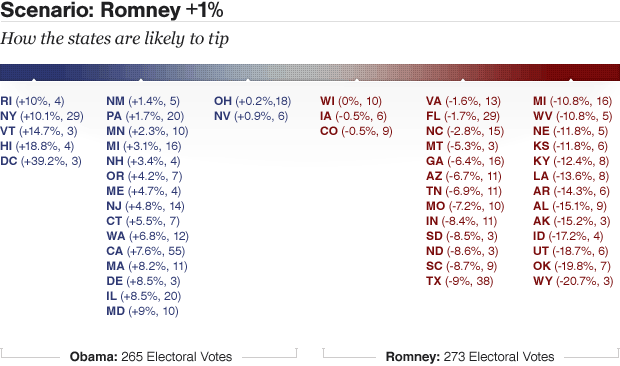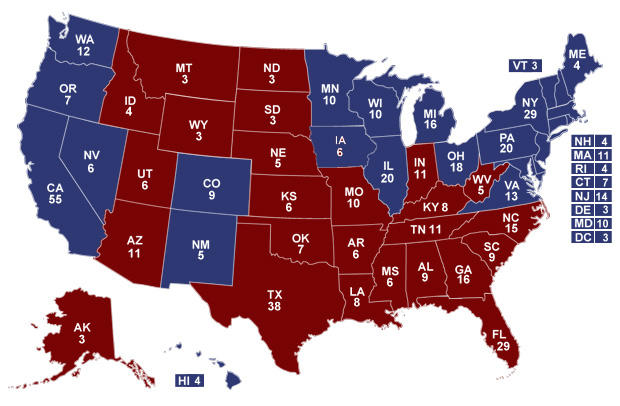Obama holds slight electoral vote edge, according to new computer simulation
By Anthony Salvanto and Doug Rivers
President Obama would hold a slight Electoral College edge if the election were today, according to a new computer simulation model, mainly because enough of the battlegrounds still tilt ever-so-slightly his way -- but he's not nearly favored for re-election to the extent he was a few weeks ago.
CBS News and YouGov's simulation shows how the national presidential vote impacts the Electoral College, following Mitt Romney's resurgence and the first debate.
We tested what would happen in the Electoral College under three very close national vote scenarios: either a slight Obama or Romney popular vote win, and a tie. The model shows us how the nation's votes would be distributed in each case, and how the states would ultimately tip one way or the other. (We tried all three scenarios because if there's one thing - and maybe the only thing - that the national polls agree on today, it's that this race is close.)
If the popular vote is tied
A tie in the national popular vote means Mr. Obama would likely get re-elected narrowly with 290 electoral votes--just over the 270 needed to win.
The president can simply tie the popular vote and still win the Electoral College because he has more state-by-state combinations to get to 270 than Romney does. So he'd most likely squeak out wins in most of the battlegrounds where he leads - enough for that 290 majority - while losing a few others, and breaking even in the popular vote. He'd rely heavily on slight wins in Ohio and smaller states like Colorado and Iowa and Wisconsin to get him there, because Romney would take larger prizes of Florida and Virginia by very small margins, as well as North Carolina.
However, this would be a razor-tight race all around: less than one percent would separate the candidates in five battleground states (Ohio, Wisconsin, Iowa, Colorado and Virginia). All told, the model shows a 65 percent chance of Mr. Obama winning in a tied popular vote scenario. And Romney is within electoral striking distance, too, because he'd likely win the big prize of Florida under this and most of the scenarios we examined. That alone gets him much closer to 270 and ups his chances.
Before we look at the other scenarios, here's more detail on how the model works: First, we estimate where the race stands at this moment in both battleground and non-battleground states using YouGov's interviews with 35,700 registered voters across the country, conducted for this project. Then, since the national vote is really just an assemblage of state votes, we look at how the states are likely to tip from their initial position as we see shifts in the national vote. We used one million computer simulations to estimate the chances of each possible Electoral College combination that could result, and from that we learn which are the most likely to occur.
Importantly, it is meant to gives us a snapshot of today, not a prediction, because it is based on current information and the current dynamics of the race.
If Romney narrowly wins the popular vote
Next we looked at what happens if Romney were to narrowly win the national vote by about one point. As of today, he'd have a better-than-even chance of translating that into a narrow electoral vote majority (about a 52 percent overall chance to win) and get to 273. Romney really needs a margin of more than one percent to be assured of winning the presidency, because he needs enough votes to tip almost all the battleground states in order to get over 270.
Note that eking out a win in the national popular vote doesn't guarantee an Electoral College victory for Romney the way it would for Mr. Obama, because it is possible for Romney to amass enough votes in places like Florida and Virginia to take the national vote but still fall short in the Electoral College if he narrowly loses other battlegrounds. We'd expect that once Romney edges past a one-point national lead, though, Romney could likely move Wisconsin, Colorado and Iowa into his column - just barely - to tip the balance and put him at 273 to Mr. Obama's 265.
And Romney would get over 270 while losing Ohio.
Still, so many states would be so close at that point that even the slightest vote shift in any of them would decide the election, rendering Romney at plus-one, almost a tossup electoral race. Once Romney goes beyond a one percent lead, he has a much better chance of running the table through the remaining battleground states.
If Obama narrowly wins popular vote
Next we tested a slight popular vote lead for Mr. Obama of two points, our own estimate from these data of where the race might be today. Not surprisingly, it translates into a little more breathing room with a win in Virginia and more comfortable wins in other battlegrounds like Colorado and Wisconsin.
If the race stays like this, on election night there will be two waves of returns to follow. First, Romney must do well in the large states in the East (Florida, North Carolina, Virginia, and Ohio) to stay in contention. Then, a second wave of states in the middle of the country (Wisconsin, Iowa, and Colorado) could end up being decisive.
Three weeks ago, before the first debate, Mr. Obama looked like a heavy favorite and was on pace for perhaps 330 electoral votes. The race is clearly much closer now. And we'll run this simulation again after the last debate, with another round of new data, and get another look at where things stand when we get into the final days.
Anthony Salvanto (@salvantocbs) is CBS News' Elections Director
Doug Rivers is Professor of Political Science at Stanford University, Chief Innovations Officer at YouGov and a CBS News Consultant.




